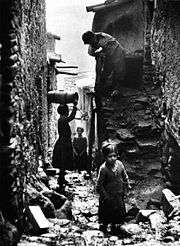Africo
| Africo | ||
|---|---|---|
| Comune | ||
| Comune di Africo | ||
| ||
 Africo Location of Africo in Italy | ||
| Coordinates: 38°03′N 16°8′E / 38.050°N 16.133°ECoordinates: 38°03′N 16°8′E / 38.050°N 16.133°E | ||
| Country | Italy | |
| Region | Calabria | |
| Province / Metropolitan city | Reggio Calabria (RC) | |
| Government | ||
| • Mayor | Domenico Versaci | |
| Area | ||
| • Total | 51 km2 (20 sq mi) | |
| Elevation | 15 m (49 ft) | |
| Population (January 1, 2009)[1] | ||
| • Total | 3,339 | |
| • Density | 65/km2 (170/sq mi) | |
| Demonym(s) | Africesi | |
| Time zone | CET (UTC+1) | |
| • Summer (DST) | CEST (UTC+2) | |
| Postal code | 89030 | |
| Dialing code | 0964 | |
| Patron saint | Saint Leo | |
| Saint day | May 12 | |
Africo (Greek: Aphrikon) is a comune in the province of Reggio Calabria, in the Southern Italian region of Calabria at 74 kilometres (46 mi) from Reggio Calabria.
Africo consists of two main centers. The first, Africo Vecchio (Old Africo), is located some 15 kilometres (9 mi) in the mainland at the feet of the Aspromonte. The old town was destroyed by disastrous floods and landslides in October 1951 and abandoned. The second, Africo Nuovo (New Africo), was reconstructed around 15 kilometres (9 mi) away, on the Ionian coast near Bianco. The remnants of the old town are situated in the Aspromonte National Park.[2]
History
The origin of the name is unclear. According to some scholars, the name may have derived from the Latin name apricus (airy and sunny) which is from the Greek aprokos. Others believe it comes from the Latin africus (ventus), winds from Africa.[2]
Africo Vecchio

The old centre was founded around the 9th century by inhabitants from Delia or Deri. In 1195 the town became a fief of the Archbishop of Reggio Calabria granted by Henry VI, Holy Roman Emperor. It remained so until the end of feudalism in Calabria in 1806.[2]
An earthquake in 1783, partially destroyed the town, killing six people. Earthquakes in 1905 and 1908 again hit the town.[2]
Africo has become the symbol of hunger, floods, wandering and the dispersion of the inhabitants of inland Calabria. In 1931 the Calabrian writer Corrado Alvaro described a famine which had afflicted Africo. In 1946, Umberto Zanotti Bianco published a book on the people of Africo, Tra la perduta gente (Amongst the lost peoples) describing the dire conditions and hunger.[3] At the time the village could only be reached by a 6/7 hour ride on a mule.[4]
In 1948 the journalist Tommaso Besozzi and photographer Tino Petrelli published a report in the magazine L’Europeo, showing the misery and hunger of the people of Africo.[4] The article, entitled Africo, symbol of disparity, and the series of documentary photographs produced an outrage from national public opinion which, at the time, was rediscovering the dramatic situation of the "southern question". The inhabitants of Africo left their village from 1949 onwards and moved to new houses built along the Ionian coast, to New Africo.[3]
Africo Nuovo
On October 15–18, 1951, floods and landslides destroyed Africo and the nearby hamlet Casalinuovo. People were evacuated to Bova Marina, Reggio Calabria and Fiumara di Muro. Africo Nuovo has been constructed around 15 kilometres (9 mi) away from the old town, on the Ionian coast, near Bianco.[2]
The town is home to the 'Ndrangheta, a Mafia-type criminal organisation based in Calabria.[5] Several of the criminal clans are sometimes involved in bloody feuds.[6]
Economy
The economy is based on agriculture and greenhouses for the cultivation of fruits, the production of cement, and forestry. Tourism is, to date, poorly exploited even though it has enormous potential.[2]
Demographic evolution

Notable people
- Giuseppe Morabito (born 1934), a notorious 'Ndrangheta boss
References
- ↑ All demographics and other statistics from the Italian statistical institute (Istat)
- 1 2 3 4 5 6 (Italian) Ricerche Storiche, Africo.net (Retrieved January 17, 2010)
- 1 2 Food and Fatness in Calabria, by Vito Teti, in Social Aspects of Obesity, edited by I. de Garine and Nancy J. Pollock, Routledge, 1995, ISBN 2-88449-186-4
- 1 2 (Italian) Africo, emblema della disperazione, by Tommaso Besozzi, L’Europeo Nr. 12, March 1948
- ↑ Farrell, Nicholas (9 April 2015). "In Italy's Poorest Town, There's Little Left to Do but Join the Mafia". Newsweek. Retrieved 8 February 2016.
- ↑ Africa Nuovo Journal: On the Toe Of Italy, the Shotgun Settles Old Scores, The New York Times, May 5, 1987
External links
- Africo, Reggio Calabria, Calabria,Italy - Civil Records 1866 to 1910.
- (Italian) Nella tana del brigante Musolino in mezzo ai picchi dell’Aspromonte, by Paolo Rumiz, La Repubblica / L'Espresso, August 6, 2011
